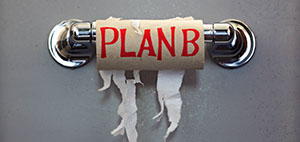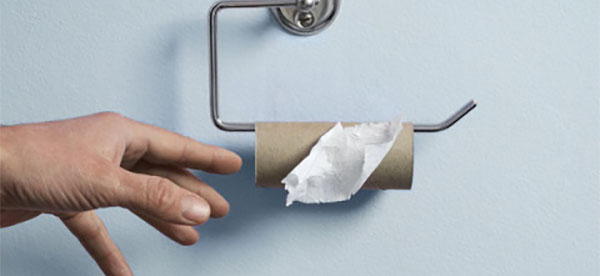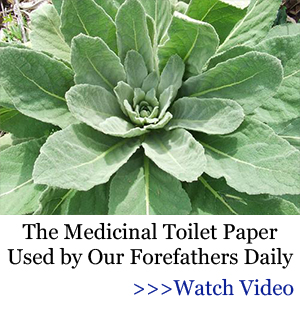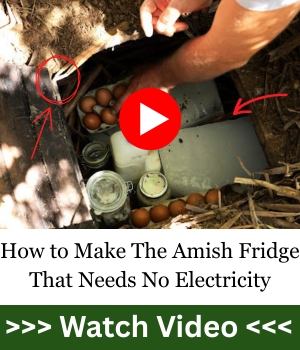When society collapses and the grocery store shelves are empty for an extended period of time, people will still need to use the toilet and that means they will still need toilet paper.
Even if it isn’t an end-of-the-world type event, if it is simply a winter storm that halts the delivery of good for two weeks and you run out of toilet paper, you are going to need to use something to get you through. Fortunately, there are homemade substitutes for toilet paper that you can generally find around your home.
Standard Alternatives
You might be out of toilet paper, but you might still have other materials around the house that would work well as a substitute for toilet paper. I’m talking about other store-bought materials, such as:
- Facial tissues (Kleenex)
- Paper towel
- Baby wipes
Just don’t flush these last two options, as they might clog up your toilet. But chances are, if you have run out of toilet paper, you are out of these, as well. For this reason, let’s take a look at other options you can find in and around the house.
Found Around the House
Other than the materials mentioned above that you can buy at the store and that can substitute for toilet paper, there are other materials that you might have laying around your home that would work as well. Here are some suggestions:
- Paper: This can be newspaper, printer paper, notebook paper, or any other paper you can find. It’s not as soft as toilet paper, but it certainly does the job. It is ideal to crumple the paper up a lot to soften it. The paper you use can be burned afterward for easy disposal.
- Sponge: A damp sponge can be used to wipe after using the toilet. This was common practice in ancient Rome, where they used to put a sponge of the end of a stick and clean themselves with that. Just know that if the sponge isn’t cleaned properly, it can easily harbor bacteria, so after each use, you should soak it in bleach water or boil it and then rinse it out.
- Water: Whether you have the water indoors or find it outside, water will rinse away anything you need to clean off yourself. You can use it in a spray bottle, get a portable bidet, use a hose, or get snow if it’s winter. A snowball works wonders! You can fill your left hand with water and wash yourself and then wash your hands very well when you are done. This is what is done in many countries where they simply don’t have the luxury of toilet paper.
Related: Storing Water for When Disaster Happens
- Cloth: You probably have all sorts of cloth lying around the house. Perhaps you have old nightgowns and PJs, old bedsheets, old towels, or any other old clothes or materials made out of fabric. The cloth is a great alternative when you are out of toilet paper and many self-sufficient folks choose to use cloth wipes despite having access to toilet paper. You can dampen it if you need to and wash and reuse, making it ideal for the whole family.
Found Outdoors
If you don’t have any materials in your home that would work as a substitute for toilet paper or you are caught away from home, then you need to start looking outside.
Fortunately, nature has supplied us with so many great natural butt wipes that you might be surprised how easy it is to get by without toilet paper. Check out these options:
- Leaves: Yes, this is the obvious option for apparent reasons. There are leaves everywhere out there. They are big, soft, and in abundant supply. Leaves you can use include:
- Maple
- Mullein
- Large-leaved aster (aka. lumberjack toilet paper)
- Cottonwood
- Hazelnut
- Thimbleberry
- Fuzzy lamb’s ear
- Grape
Of course, there are plenty of other options. The most important thing to remember is to know your poisonous plants and avoid them. The last thing you want to do is wipe your sensitive parts with poison ivy, poison oak, or poison sumac! Stay away from plants that have leaves in groups of three.
- Pine needles: These are really a type of leaf, and yes, they can be used to effectively wipe after using the toilet. Granted, pine needles aren’t the softest alternative, but they do a good job.
- Moss: If you have access to moss, that is a great substitute for toilet paper. You can generally pick the moss up in a chunk and wipes with it. You just need to be careful that the moss doesn’t fall apart while you are using it.
- Pine cones: Pinecones don’t sound like they would be terribly comfortable, but they will do a good job of scraping off anything that needs to be cleaned away. Plus, there is no shortage of them, whether you are in the city or in a rural area.
Related: How Our Forefathers Made Glue Out of Pine Resin
- Hemp: If you have access to hemp plants, you will have plenty of alternative toilet paper. Hemp grows quickly and is sustainable.
- Corn husks and cobs: This was the classic cleansing item for farmhouses in the pioneer days simply because they grew so much corn. The husks would be saved and set aside and taken to the outhouse to use as wipes. They would simply be stored in the outhouse for use when needed. If they were needed in the winter, the corn husks would be dried. Even after toilet paper became available, many people still used corn husks. Corn cobs have also been used to clean after toilet use, but the husks would be far more comfortable.
- Stones: As odd as this sounds, a small- to a medium-sized stone that is flat and smooth (smooth is important!) can be used to clean after the use of the toilet. Many ancient societies used a stone such as this to clean up after toilet use.
How to Make Your Own Toilet Paper
 Who knew there were so many alternatives when it comes to toilet paper? But what if you could actually make your own toilet paper? If you have paper lying around the house, then you can! Here is what you will need:
Who knew there were so many alternatives when it comes to toilet paper? But what if you could actually make your own toilet paper? If you have paper lying around the house, then you can! Here is what you will need:
- Any paper, except for glossy magazine paper
- A pot
- Water
- Aloe, baby oil, or any type of unscented lotion (these act as softening agents)
- Witch hazel (optional; acts as an antibacterial agent)
- Grass and leaves
- Rolling pin
- Mallet or hammer
- Sheet or towel
- Ladle or spoon
- Large cutting board or other flat board
To make toilet paper, follow these steps:
- Soak the paper in water first to remove as much ink as you can, especially if you are using newspaper. Once at least ¾ of the ink has seeped out of the paper you can pull it from the soak water.
- After you soak the paper, place it in a pot with two handfuls of grass and leaves and cover with water. Bring this to a boil and allow it to simmer at a low temperature for one hour.
- Bring the water to a rolling boil for half an hour. You can add water as necessary and you will find foam forms on top that you will need to remove.
- After boiling, the paper becomes pulp. You will now remove the pot from the heat and remove the water from the pot without disturbing the pulp. The best method is to scoop out most of the hot water, leaving the pulp intact, and then let the rest cool. If you do need to remove the pulp from the pot, do not let it dry out. You will need to put it back into the pot when the water is gone.
- Once the pulp has been put back into the pot, mix in 4 tablespoons of oil or lotion, which will soften the paper, and just a few drops of witch hazel, if you are using it.
- Spread the pulp mixture on a towel or sheet spread on a hard flat surface. You can roll it out with the rolling pin, getting it as thin as possible. If there are lumps, you can hammer these down with the mallet.
- Lay the board on top of the rolled out pulp and weight down with heavy objects.
- After 30 minutes, remove the weights and the board. You can then turn the towel or sheet over and pull it off of the toilet paper.
- Put the toilet paper out in the sun to dry.
- Once dry, you can cut it into strips.
Whether you have the time, the ingredients, and to equipment to make your own toilet paper or you want to find a substitute, the fact is that when society collapses or there is an event that disrupts life for a period of time, you will need something to wipe yourself after using the toilet. After all, when the SHTF you just never know if or when you will see store-bought toilet paper again, so you really need to learn how to make your own or find alternatives that work.
You may also like:
Similar to Morphine: The Best Natural Painkiller that Grows in Your Backyard
The U.S. Army’s Forgotten Food Miracle (Video)
How to Build a 44-Day Stockpile for Only $2.40 a Day
How To Store Six Months of Food When You Only Have Space for One























This site always has wonderful tips. Thank you so much.
Egad!!
Some of these “alternatives” sound horrendous!!
I’ll take two 12-packs of Angel Soft Mega-rolls, please!!
Many packages now come with paper as cushion against breakage. I smooth the paper out and cut it in 6 x 6 pieces. I store it in a box, smashing it down until it is jammed full of the paper. I then seal the box and put it in my storage shed. It stores flatter than toilet paper, each small box holds 700 or 800 sheets of this paper. If someone needs to trade for t.p., this will be my trade paper. It’s not flushable, but the toilets will stop working shortly after the grid goes down, so anyone who is smart will stop flushing immediately and save whatever water is in the system for drinking purposes.
Thanks for another helpful tip about making one’s own paper.
Why do you add grass and leaves?
Newsprint has low fiber content. By dissolving the paper back into slurry again, you further break up the fibers in the paper which is what give the paper strength. The best paper is made with cotton or linen cloth which has lots of long fiber in it. At one time the paper industry was located in the Northeast ie, Mass, N.H. Conn.. Mummy wrappings which were linen were imported to make paper. The problem with that was anthrax spores contained in the mummy wrappings were reactivated by the pulping process and the resulting anthrax epidemic nearly wiped out the paper industry in the Northeast — well, not the industry, just all the workers.
If you watch handmade paper being made, the pulp slurry is screened to allow the water to drain. A large wooden frame is used and the slurry is smoothed out in the frame and the water allowed to drain. Handmade paper has a much rougher finish than machine made paper.
Paper has two sides, a felt side and a wire side. On a fourdrinier machine, which is the standard paper making machine, the pulp slurry is squeezed between a felt or smooth roller and a wire screen. The felt side of the paper is the smoother side, although in most cases one must examine the paper closely in order to determine which side is which. Letterhead is always printed on the felt side unless a special effect is wanted.
How do I know all this trivia? I owned a printing company for 25 years.
The advice on being careful about plants with three leaves is important. Had a friend when I was in ‘scouts’ who used poison ivy,( but only once)…the details I won’t print because some people may have just eaten something. Let’s just say…he suffered, intensely, for about a month. Trying to keep “that area” dry and protected…was, at the very least…interesting.
You also need to be sure to check the area if you are answering nature’s call outdoors. I have a relative that can get a poison oak reaction if he is even near the stuff on a hot summer day. Apparently the oil that causes the rash is released into the air on a hot day and will cause a rash on those persons who are really susceptible to the irritant. I would think one might be especially susceptible in those regions that are not ordinarily exposed to open air. Makes my skin feel itchy just contemplating it.
Good point, ouch! He should have made a paste of Bentonite clay and water and he wouldn’t have suffered. It also works for nettles.
What is bentonite clay and where is it found–what part of the country and what part of the ecosystem? Thanks.
Phone book pages work great , and there strong — just crumple the page up for 5 to 10 second’s and that’s it. You can put 200 12 x12 in. pages ( folded ) in pocket or pack with the greatest of ease . So don’t throw that PHONE BOOK away .
With people having cell phones phone books are VERY hard to find.
I am 75 years old. My maternal grandparents did not have electricity or indoor plumbing when I was a kid. I spent summers ‘ down on the farm’. Good experience for what is to come. The Sears and Monkey Ward ( Montgomery Ward) catalogs served two purposes in the outhouse!
I use newspapers, which easily rip in a certain direction, for appropriate widths… then I simply keep a small yogurt container of water near by, dip the paper to soften it, and use it… throwing it immediately into my 5 gal bucket, which I have just used for toilet/compost pail- along with any green waste from the kitchen… cover immediately with a bit of earth and there is no smell, it starts to compost right away, and if you put it in a place in your garden where you don’t grow food in it for 4 years, it is safe to use for growing food after that…
Mullein leaves actually have little tiny hairs on them and using the wrong side can really irritate the skin.
I grew up on a small farm that was modernized, but my grandparents, with whom we spent much time often did not have indoor facilities. Much of this is familiar to me. Also, I visited Russia in dead winter and in some of the more rural areas outside Moscow did not have anything at all like what we enjoy. Some of them kept “paper” available in a can near the toilet; news papers, magazines, etc. torn into small pieces.
AND, I was a Girl Scout leader and camp director for several years and some of the older scouts often went on nature trips for as much as a week at a time. This was VERY useful training and I count it a blessing to have learned so many things in Scouting. Too bad its being destroyed by some ‘modern,current day’ thinking, but those of us who were privileged to experience it were truly blessed.
Thank you for all you do to help enlighten us today.
da
Thank you for all the very helpful articles
which bring back memories living through 6 years of WWII in Europe. I know tricks my mother used when I had ear infection and no doctor around. Mother cooked potato peel and put it in an cloth and wrapped it around my ears using an old scarf to hold it in place the heat draws out the
infection. News paper and old paper bags were used as toilet paper. I had to cut them up in usable sizes and crumble them. We fermented cabbage We made shoe soles out of corn husk which we braided and stitched on strips of old material from shirts etc. to make sandals. Today at age 81 I never last the prep time of war. I’m still know as a hoarder. The only problem I have not resolved is the water shortage. I have water filters but this is no help if there is no water.
.
I really enjoyed reading your comment I’m very interested in hearing and knowing what and how things were done back then so ty for sharing
Depends on your area. I’m in the desert. Will put gutters on my house to do “rain water’ catch. Usable for gardening and filtered, for drinking. Found empty food grade totes. A was mourning the system not up. We got 1/2′ last week. That’s 1/2 ‘ tall on every square inch of space on my roof. Lots of water, if careful.
1) Nalgene ‘Wash bottle’, like used in labs, like a ‘personal mini-bidet’..
2) Those ‘mini compressed “tablet” towels’, 1000 – reusable – towels for $45.-ish..
3) 1000 vinyl gloves (for poo) are CHEAP.. jus sayin..
Don’t forget to do what dry hikers do. Dedicate a wash cloth to use over and over for urine. Use a piece of crumpled paper for the other.
You can flush your toilet with about 1-1/2 gallons of water on the newer toilets. Use gray water (non-drinkable). Pour one gallon in the tank and 1/2 gallon in the bowl.
You can divert the sink & shower drains to a holding tank for gray water flush. Would like to have that, modern cities are too squemish.
Only around here.. Oh well.
Change your diet starting today.
Our closest relatives.. Chimps , Great Apes get by.
Diet.. Lots of leafy green roughage..
Well in a survival situation you may not get your salads.. but you can change your diet starting today to get a different waste product ,
Learn how to eliminate bulk waste standing up.. don;’t try this one around the house. lol
I would avoid.. leaves and moss etc. Cross contamination can be a problem..
I have lived around Mud Huts an Outhouses and even there people found ways to make things work..
That being said.. I keep 12 cases of POM in my Supply Room LOL
Hi! we are going to conduct a research about water soluble tissue paper that is made of recycled material. Could you help us out what chemical is safe to put on the process of making a home made tissue? thankyou. It would be a big help to us
Re-read the article above. Paper is broken down by soaking in water and heating. The whole article is about using recycled paper to make paper for use in sanitary activities. No chemicals are needed. The fibers are broken down by water and heat. The only suggestion I would make about the article is to make a frame and cover it with window screen. That will allow the water to drain from the slurry. That is how paper was traditionally made and today, if you take a class in making washie, Japanese paper, that is what they use to drain the slurry in making washie. The size of the screen will dictate the size of the sheet that you wind up with. If you don’t use window screen, use cheese cloth or muslin to allow the water to drain.
I don’t know what you have in mind from your post, but I would recommend getting a book on paper making. I am sure Amazon has at least one such book and probably a whole library worth of books on paper making.
Amazon has lots of copies of Art of the Deal. The reviews say “Many pages. Perfect!”
I’ve collected dryer lint to make homemade paper from, using the screening method. Works very well.
you guys forgot old telephone book pages. These are a ‘go to’ for me.
For young mums with TP shortage in the Western Australian bush: I’m a mummy of 2 year old quadruplets. After dinner time, these buggers are chockers – so I have them line up at the dunny to drop their daks and drop a snag. Then I let them loose in the yard with soap and water filled water blasters to play “Hit the Brown Eye Down Unda” (instead of the bull’s eye…) By the time they’re cleaned, they’re buggered, ready for bed and I’m ready for a coldie! It should only be for kindies and younger, butt I’m sure there are plenty of bushie bogans looking for a clean way to cool off!
For young mums with TP shortage in the Western Australian bush: I’m a mummy of 2 year old quadruplets. After dinner time, these buggers are chockers – so I have them line up at the dunny to drop their daks and drop a snag. Then I let them loose in the yard with soap and water filled water blasters to play “Hit the Brown Eye Down Unda” (instead of the bull’s eye…) By the time they’re cleaned, they’re buggered, ready for bed and I’m ready for a coldie! It should only be for kindies and younger, butt I’m sure there are plenty of bushie bogans looking for a clean way to cool off!
You can break down cardboard the same way. If you have lots of boxes around, they will make great paper too.